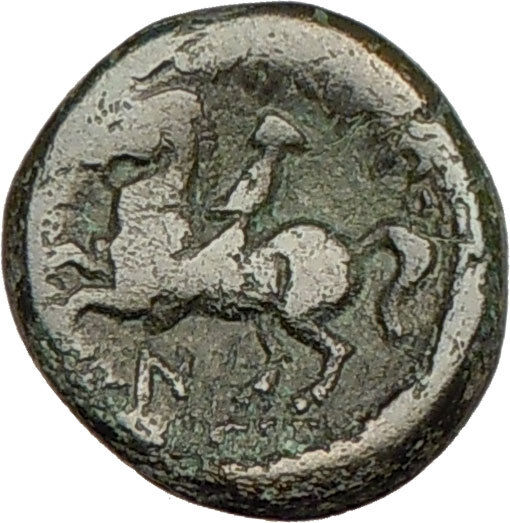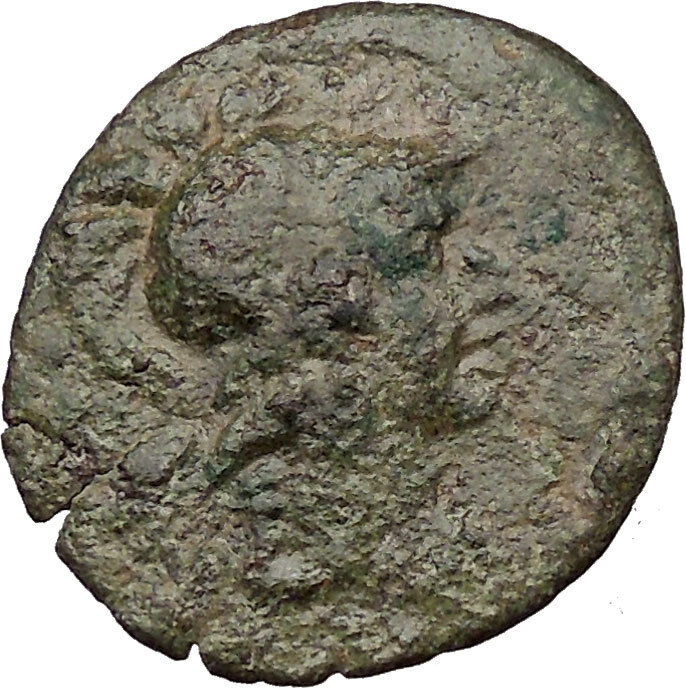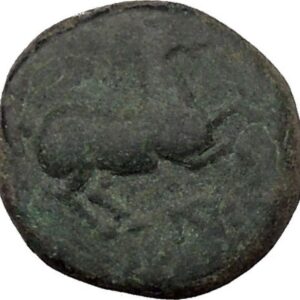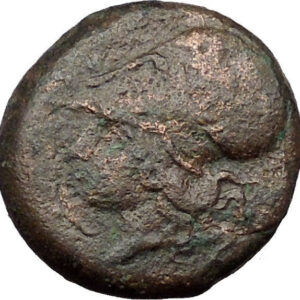|
Greek city of Larissa in Thessaly for the Thessalian League
Bronze 16mm (4.96 grams) Struck circa 50-27 B.C.
Reference: HGC 4, 230
Head of Athena right in Corinthian helmet right.
ΘEΣΣAΛΩN, Horse prancing right.
Larissa was an important town of Thessaly, in Pelasgiotis, situated on the Peneios river, in an extensive plain. It was once the capital of the Pelasgi, and had a democratic constitution, but subsequently became subject to the Macedonians. It retained its importance under the Romans, and after the time of Constantine the Great, became the capital of the province of Thessaly. This city was named after a local water nymph named Larissa. The story goes that the nymph drowned while playing ball on the banks of the Peneios River. In Greek mythology, the Greek hero Perseus accidentally killed his grandfather, King Akrisios of Argos when participating in the funeral games held in the city for nymph Larissa. The people of that city made their wealth from the rich agricultural area around the city and from breeding horses.
Following the great victory of the Roman general Flamininus over Philip V of Macedonia, in 197 B.C., the freedom of the Greeks was proclaimed at Corinth and a number of new autonomous coinages were initiated. One of the coinages was struck by the Thessalian League. The Thessalian League was a loose confederacy of feudal-like city-states and tribes in the Thessalian valley in Northern Greece and was run by a few aristocratic families from Thessaly (Aleuadae and Skopadae). The headquarters of the Thessalian League was Larissa, which struck coins for the league, in the name of Thessaly bearing inscriptions ΘEΣΣAΛΩN.
You are bidding on the exact item pictured, provided with a Certificate of Authenticity and Lifetime Guarantee of Authenticity.
 Athena or Athene (Latin: Minerva), also referred to as Pallas Athena, is the goddess of war, civilization, wisdom, strength, strategy, crafts, justice and skill in Greek mythology. Minerva, Athena’s Roman incarnation, embodies similar attributes. Athena is also a shrewd companion of heroes and the goddess of heroic endeavour. She is the virgin patron of Athens. The Athenians built the Parthenon on the Acropolis of her namesake city, Athens, in her honour (Athena Parthenos). Athena’s cult as the patron of Athens seems to have existed from the earliest times and was so persistent that archaic myths about her were recast to adapt to cultural changes. In her role as a protector of the city (polis), many people throughout the Greek world worshiped Athena as Athena Polias (“Athena of the city”). Athens and Athena bear etymologically connected names. Athena or Athene (Latin: Minerva), also referred to as Pallas Athena, is the goddess of war, civilization, wisdom, strength, strategy, crafts, justice and skill in Greek mythology. Minerva, Athena’s Roman incarnation, embodies similar attributes. Athena is also a shrewd companion of heroes and the goddess of heroic endeavour. She is the virgin patron of Athens. The Athenians built the Parthenon on the Acropolis of her namesake city, Athens, in her honour (Athena Parthenos). Athena’s cult as the patron of Athens seems to have existed from the earliest times and was so persistent that archaic myths about her were recast to adapt to cultural changes. In her role as a protector of the city (polis), many people throughout the Greek world worshiped Athena as Athena Polias (“Athena of the city”). Athens and Athena bear etymologically connected names.

Larissa was an important town of Thessaly, in Pelasgiotis, situated on the Peneios river, in an extensive plain. It was once the capital of the Pelasgi, and had a democratic constitution, but subsequently became subject to the Macedonians. It retained its importance under the Romans, and after the time of Constantine the Great, became the capital of the province of Thessaly. This city was named after a local water nymph named Larissa. The story goes that the nymph drowned while playing ball on the banks of the Peneios River. In Greek mythology, the Greek hero Perseus accidentally killed his grandfather, King Akrisios of Argos when participating in the funeral games held in the city for nymph Larissa. The people of that city made their wealth from the rich agricultural area around the city and from breeding horses.
Traces of Paleolithic human settlement have been recovered from the area, but it was peripheral to areas of advanced culture. The area around Larissa was extremely fruitful; it was agriculturally important and in antiquity was known for its horses. The name Larissa is in origin a Pelasgian (pre-Greek) word for “fortress”. There were many ancient Greek cities with this name. The name of Thessalian Larissa is first recorded in connection with the aristocratic Aleuadai family. Larissa is thought to be where the famous Greek physician Hippocrates and the famous philosopher Gorgias of Leontini died.
When Larissa ceased minting the federal coins it shared with other Thessalian towns and adopted its own coinage in the late 5th century BC, it chose local types for its coins. The obverse depicted the nymph of the local spring, Larissa, for whom the town was named; probably the choice was inspired by the famous coins of Kimon depicting the Syracusan nymph Arethusa. The reverse depicted a horse in various poses. The horse was an appropriate symbol of Thessaly, a land of plains, which was well known for its horses. Usually there is a male figure; he should perhaps be seen as the eponymous hero of the Thessalians, Thessalos, who is probably also to be identified on many of the earlier, federal coins of Thessaly.
Larissa, sometimes written Larisa on ancient coins and inscriptions, is near the site of the Homeric Argissa. It appears in early times, when Thessaly was mainly governed by a few aristocratic families, as an important city under the rule of the Aleuadae, whose authority extended over the whole district of Pelasgiotis. This powerful family possessed for many generations before 369 BC the privilege of furnishing the tagus, the local term for the strategos of the combined Thessalian forces. The principal rivals of the Aleuadae were the Scopadac of Crannon, the remains of which are about 14 miles south west.
Larissa was indeed the birthplace of Meno, who thus became, along with Xenophon and a few others, one of the generals leading several thousands Greeks from various places, in the ill-fated expedition of 401 (retold in Xenophon’s Anabasis) meant to help Cyrus the Younger, son of Darius II, king of Persia, overthrow his elder brother Artaxerxes II and take over the throne of Persia (Meno is featured in Plato’s dialogue bearing his name, in which Socrates uses the example of “the way to Larissa” to help explain Meno the difference between true opinion and science (Meno, 97a-c) ; this “way to Larissa” might well be on the part of Socrates an attempt to call to Meno’s mind a “way home”, understood as the way toward one’s true and “eternal” home reached only at death, that each man is supposed to seek in his life).
The constitution of the town was democratic, which explains why it sided with Athens in the Peloponnesian War. In the neighborhood of Larissa was celebrated a festival which recalled the Roman Saturnalia, and at which the slaves were waited on by their masters. As the chief city of ancient Thessaly, Larissa was taken by the Thebans and later directly annexed by Philip II of Macedon in 344. It remained under Macedonian control afterwards, except for a brief period when Demetrius Poliorcetes captured it in 302 B.C.
It was in Larissa that Philip V of Macedon signed in 197 BC a treaty with the Romans after his defeat at the Battle of Cynoscephalae, and it was there also that Antiochus III the Great, won a great victory in 192 BC. In 196 BC Larissa became an ally of Rome and was the headquarters of the Thessalian League. Larissa is frequently mentioned in connection with the Roman civil wars which preceded the establishment of the Roman Empire and Pompey sought refuge there after the defeat of Pharsalus.
Thessaly was home to extensive Neolithic and Chalcolithic cultures around 6000-2500 BC (see Cardium Pottery, Dimini and Sesklo). Mycenaean settlements have also been discovered, for example at the sites of Iolcos, Dimini and Sesklo (near Volos). In Archaic and Classical times, the lowlands of Thessaly became the home of baronial families, such as the Aleuadae of Larissa or the Scopads of Crannon. In the 4th century BC Jason of Pherae transformed the region into a significant military power, recalling the glory of Early Archaic times. Shortly after, Philip II of Macedon was appointed Archon of Thessaly, and Thessaly was thereafter associated with the Macedonian Kingdom for the next centuries. Thessaly later became part of the Roman Empire as part of the province of Macedonia.
|





 Athena or Athene (Latin: Minerva), also referred to as Pallas Athena, is the goddess of war, civilization, wisdom, strength, strategy, crafts, justice and skill in Greek mythology. Minerva, Athena’s Roman incarnation, embodies similar attributes. Athena is also a shrewd companion of heroes and the goddess of heroic endeavour. She is the virgin patron of Athens. The Athenians built the Parthenon on the Acropolis of her namesake city, Athens, in her honour (Athena Parthenos). Athena’s cult as the patron of Athens seems to have existed from the earliest times and was so persistent that archaic myths about her were recast to adapt to cultural changes. In her role as a protector of the city (polis), many people throughout the Greek world worshiped Athena as Athena Polias (“Athena of the city”). Athens and Athena bear etymologically connected names.
Athena or Athene (Latin: Minerva), also referred to as Pallas Athena, is the goddess of war, civilization, wisdom, strength, strategy, crafts, justice and skill in Greek mythology. Minerva, Athena’s Roman incarnation, embodies similar attributes. Athena is also a shrewd companion of heroes and the goddess of heroic endeavour. She is the virgin patron of Athens. The Athenians built the Parthenon on the Acropolis of her namesake city, Athens, in her honour (Athena Parthenos). Athena’s cult as the patron of Athens seems to have existed from the earliest times and was so persistent that archaic myths about her were recast to adapt to cultural changes. In her role as a protector of the city (polis), many people throughout the Greek world worshiped Athena as Athena Polias (“Athena of the city”). Athens and Athena bear etymologically connected names.





